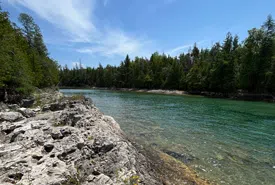The Nature Conservancy of Canada says thanks to donations and contributions from the federal and provincial governments, a piece of the Saugeen Bruce Peninsula is protected from development.
The 29-hectares of land west of Tobermory in an area known as China Cove was purchased by the Nature Conservancy (NCC) from a private owner who had plans to develop it, but was amenable to protecting the land if the NCC bought it for about $3.25 million.
NCC Program Director, Midwestern Ontario, Esme Batten says “The property protects nearly 1km of undeveloped Lake Huron shoreline, intact forests, thriving wetlands and globally rare alvars”
The NCC says the purchase and conservation project was made possible by the support of many individuals, foundations and partners including the $942,000 from the federal government the Nature Smart Climate Solutions Fund and from $300,000 the Ontario government through the Greenlands Conservation Partnership Program, Bruce Power’s Environment and Sustainability Fund and The Catherine and Maxwell Meighen Foundation.
China Cove was originally named after the China, a two-masted schooner that wrecked offshore in 1883. The NCC has renamed its property Aah Mahwi Nibi (Crying Water) based on the recommendation of an elder, Miptoon, from the Chippewas of Nawash Unceded First Nation. The name represents the water crying out, telling stories of the wreck of the China.
The nature conservancy says all but 8 kms of shoreline on the northern Saugeen Bruce Peninsula has either already been developed or is protected. “These habitats are really important for many species including fish like lake trout and whitefish that spawn in near shore waters and we’re really happy that we’re able to prevent the property from being developed into the seven homes that it could have been developed in,” says Batten.
She continues, “It was subdivided into seven building lots with pre-approved building envelopes so it was really such a great success that the property can continue to support great biodiversity and people can enjoy it in perpetuity.”
Batten says, “The peninsula, Manitoulin and other places in the province support some of North America’s rarest habitats called alvars.”
She explains, “They’re really unique ecosystems defined by shallow soil over dolostone bedrock or limestone bedrock and they go through periods of extreme flooding in the spring and fall, really intense drought in the summer reaching temperatures up to 52 degrees Celsius and so the species that have adapted to live there are really kind of uniquely positioned to survive in these really harsh environments and many of them are at risk or globally rare and not really found many other places in the world. So we have a unique opportunity to protect these habitats.”
She says they have some of the highest density of gastropods or snails that are found in North America and the trees that cling to life along alvars can sometimes be hundreds of years old despite being very small.”
Batten says they’re getting to work on the property, explaining, “Right now our team of biologists is doing detailed inventories of the property to help develop a stewardship or property management plan. So that plan is going to help us identify what rare species and habitats are there, where they are, figure out what’s threatening them, so it could be something like invasive species, and then work to create a comprehensive plan on how to ensure that those species can continue to thrive there in the future.”
She says part of that plan is working with neighbours and community organizations and others on the peninsula to best understand how to protect the rare habitats, the species at risk and what visitor infrastructures might be needed.
She says NCC works to allow access to their properties for things like hiking, birdwatching and nature appreciation, “Right now we’re just working through our plan of what will be possible on the property,” says Batten.



